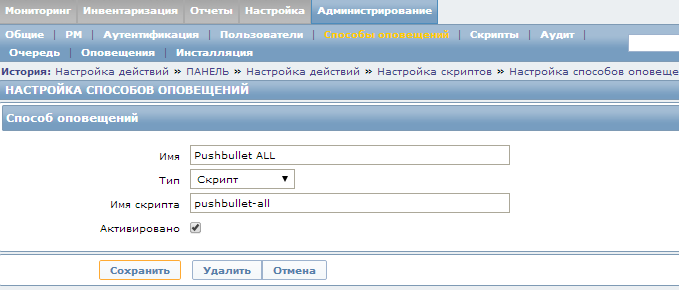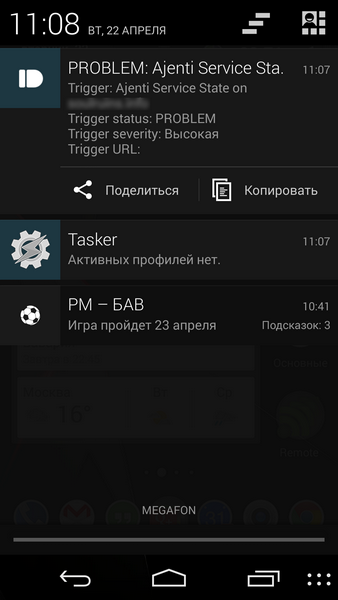Zabbix + Pushbullet: a simple way to push alerts
In our company, the main way to notify Zabbix monitoring system events is by email. Jabber did not catch on due to low prevalence, and SMS is outdated (albeit very versatile). I wanted to offer another alternative, which became push-notifications.
Pushbullet service has already managed to make a name for itself on the Android platform, and more recently it has been trying to conquer iOS . Pushbullet is able to send "pushes" to phones, receive them in the browser ( Chrome and Firefox ) and send from it again. In general, a very convenient and useful service, which plus has an open API . Through this API, we will send Zabbix events to employee phones.

It is assumed that you already have an account on this service. In this case, simply go to your profile settings .

')
Create a bash script to send push notifications to all devices . Call it
Where
A little later, in the comments, we began to offer different versions of scripts for sending messages to specific devices . In principle, this method can be used both instead of and in conjunction with what is indicated above. I decided to add variation and use scripts together. Name the new script
Now, in the field “Send to” we indicate not only the API, but also the device identifier. You can find out their list in the following way:
The “Send to” field will look like this (separator "
Where



Accordingly, each responsible employee indicates a personal API in his profile and starts receiving notifications.

UPD_02.08.2014: Updated the article. Added a script to send to specific devices and using API v2 from Pushbullet.
Pushbullet service has already managed to make a name for itself on the Android platform, and more recently it has been trying to conquer iOS . Pushbullet is able to send "pushes" to phones, receive them in the browser ( Chrome and Firefox ) and send from it again. In general, a very convenient and useful service, which plus has an open API . Through this API, we will send Zabbix events to employee phones.

Step 1: Get to know your Pushbullet API
It is assumed that you already have an account on this service. In this case, simply go to your profile settings .

')
Step 2: Create a bash script
Option 1: Send messages to all devices
Create a bash script to send push notifications to all devices . Call it
pushbullet-all #!/bin/bash API_KEY="$1" SUBJECT="$2" MESSAGE="$3" curl https://api.pushbullet.com/v2/pushes \ -u $1: \ -d type=note \ -d title="$SUBJECT" \ -d body="$MESSAGE" \ -X POST Where
$N are variables. $1 - a unique API (later indicated in the Zabbix user profile), $2 - will be the title, $3 - will become the message body. Read more in Zabbix help .The script must be copied to thealertscriptsfolder of your Zabbix server (for example:/usr/local/share/zabbix/alertscripts). Do not forget to make the script executable (chmod +x pushbullet-all).
Option 2: Send messages to specific devices
A little later, in the comments, we began to offer different versions of scripts for sending messages to specific devices . In principle, this method can be used both instead of and in conjunction with what is indicated above. I decided to add variation and use scripts together. Name the new script
pushbullet-dev : #!/bin/bash API_KEY="${1%%_*}" DEV_ID="${1#*_}" SUBJECT="$2" MESSAGE="$3" curl https://api.pushbullet.com/v2/pushes \ -u $API_KEY: \ -d device_iden=$DEV_ID \ -d type=note \ -d title="$SUBJECT" \ -d body="$MESSAGE" \ -X POST The script must be copied to thealertscriptsfolder of your Zabbix server (for example:/usr/local/share/zabbix/alertscripts). Do not forget to make the script executable (chmod +x pushbullet-all).
Now, in the field “Send to” we indicate not only the API, but also the device identifier. You can find out their list in the following way:
curl -u <your api key here>: https://api.pushbullet.com/api/devices The “Send to” field will look like this (separator "
_ "): api_dev Where
api is your API key ( api_key ), and dev is your device identifier ( dev_iden ).Below are the screenshots for option 1, with the second one just keep in mind that the script name ispushbullet-dev, and in the “Send to” field you need to specify both theAPIand theID.
Step 3: Configure Zabbix
Create a new alert method (Administration - Alert Methods)

Create a new action, on the “Operations” tab define a new type of notifications

In the user profile settings, specify your API Key

Accordingly, each responsible employee indicates a personal API in his profile and starts receiving notifications.
Step 4: Enjoy

UPD_02.08.2014: Updated the article. Added a script to send to specific devices and using API v2 from Pushbullet.
Source: https://habr.com/ru/post/220379/
All Articles